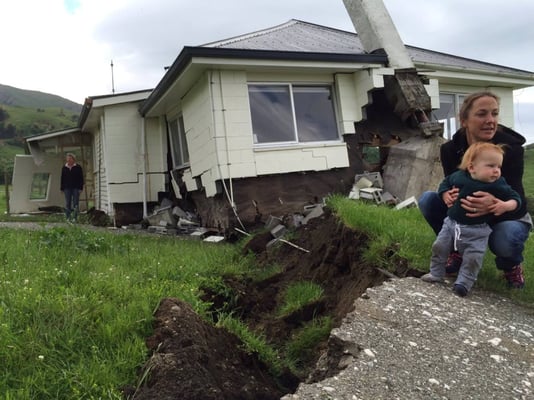New Zealand’s night of shakes

An almost two-minute long and magnitude 7.5 severe earthquake struck 15 km northeast of Culverden at 12:02 a.m. on Monday, November 14 in North Canterbury, the effects of which was widely felt throughout New Zealand, including Christchurch and Wellington. Since then, more than 1,600 earthquake aftershocks have occurred, of which 300 are of magnitude-4, 43 of magnitude-5, and two of magnitude-6.
A local state of emergency has been declared in Canterbury and a national relief support effort is underway, with major damages, including two deaths, being reported from the Kaikoura region, 180 km north of Christchurch. The small town, famous for its whale-watching tourism industry, has been cut off from the rest of New Zealand with State Highway 1 road and rail tunnels blocked by slips.
Commenting on the magnitude of the Monday morning quake, Geonet informed, “This earthquake was the largest recorded in New Zealand since the M7.8 Dusky Sound earthquake in 2009. But, given its location, it was more widely felt and more damaging. It looks like we’ve got two separate but related quakes going on. Our reports indicate that the combination of these two quakes lasted two minutes, with the most severe shaking at around 50 seconds. It was widely felt throughout both the North and South Islands. It looks like one was a strike-slip and the other was a thrust fault.”
Impact—Tsunami and landslides
The M7.5 earthquake triggered up to 100,000 landslides in northern Canterbury and southern Marlborough, most notable of which was the breaching of the slip dam holding back the south side of the Clarence River near Kaikoura, sending down almost one million cubic metres of water downstream.
A tsunami warning was also issued by the Christchurch Civil Defence and Emergency Management on Monday morning at around 3:15 a.m., almost three hours after the quake. Civil Defence Controller John Mackie instructed people in low-lying coastal areas within one kilometre of the Canterbury coast to evacuate inland or head to higher ground. Later by 5 a.m., three evacuation centres were opened in Christchurch at Akaroa School Hall (with around 25 people), Linwood College (with around 300 people) and Mairehau School (with around 50 people). By 8:10 a.m., people who were evacuated were allowed to go home after the danger was averted.
.jpg)
Kaikoura area (Photo- NZ Defence Force)
Apart from the partial destruction of a 100-year-old historic and popular homestead at Little Pigeon Bay on the Banks Peninsula just across Port Hills in Christchurch, the tsunami waves of 2.5 metres in Kaikoura, one metre in Christchurch, and half-a-metre in Wellington didn’t cause much damage to properties.
But surprisingly, and making the matters worse, the Canterbury Police received around 19 reports of burglars targeting homes in Canterbury after residents fled due to the tsunami warning. The police has promised to catch the culprits soon.
PM Key surveys the affected areas
Prime Minister John Key, who along with Civil Defence Minister Gerry Brownlee and Transport Minister Simon Bridges, did an aerial survey of the affected area twice—first on Monday and then again on Wednesday—noted that the damage in the Kaikoura region is “worse” than he thought and will “take months to repair”. He also informed that there have been two quake-related fatalities—one in Kaikoura and another in Mt Lyford, north of Canterbury.
Also, there have been reports of more than 20 quake-related injuries.
The PM also added that his ministers—from Business Innovation and Employment, Social Development and the Inland Revenue—are working on a business support package for the touristic town of Kaikoura.
Kaikoura
Giving an update on the rescue and relief efforts, the Ministry of Civil Defence and Emergency Management said, “More than 400 people have been airlifted out of Kaikoura, with NZ Defence Force NH90 helicopters been deployed to transport staff and resources to communities in the Hurunui and Kaikoura districts and assist with evacuations. The HMNZS Canterbury and HMNZS Wellington are en-route to Canterbury to assist in the response.”
%20.jpg)
Evacuation in Kaikoura (Photo- NZ Defence Force)
The evacuees were taken to Woodend and Christchurch. The local Takahanga Marae, volunteers and local businesses also opened their doors to serve food and provide shelter to hundreds of stranded tourists.
On Wednesday, the Christchurch City Council added, “An Air Force C-130 Hercules is bringing a generator and a water desalination system from Auckland to Kaikoura this morning. The Hercules will also airdrop about 5,000 litres of water to the town’s residents in the afternoon.
“International partners are also playing a vital part in the relief effort, with warships from Australia, Canada, and the United States sailing overnight to the South Island’s east coast. HMNZS Te Kaha and USS Sampson are also en-route to provide support. New Zealand Army soldiers from Burnham Military Camp will today join an Urban Search and Rescue team from the New Zealand Fire Service to assess the damage,” the Council informed.
.jpg)
South of Clarence (Photo- RNZ/Rebekah Parsons-King)
Canterbury medical officer of health Dr Alistair Humphrey and two Canterbury DHB health protection officers have also flown to Kaikoura to provide public health support to affected people.
Wellington
In the capital’s CBD, authorities have closed Molesworth Street because of the risk of a 10-storey-high building collapse. Additionally, the Wellington headquarters of the Defence Force at 2 Aitken Street, Tennyson Apartments in central Wellington, some houses at Collina Terrace, and Statistics New Zealand’s office at Harbour Quay, have also been deemed unsafe and evacuated.
Cricket Test match on schedule
But in Christchurch, which escaped any damage this time, business is carrying on as usual. A New Zealand Cricket spokesperson has informed that the first Test between the touring Pakistani team and Black Caps will go ahead as scheduled on November 17. The Pakistan team, which was in Nelson at the time of the quake and are now in Christchurch, were understandably shaken by the experience. But NZC is giving them all the support they need and the teams are preparing for the Test as usual, the spokesperson said.
An almost two-minute long and magnitude 7.5 severe earthquake struck 15 km northeast of Culverden at 12:02 a.m. on Monday, November 14 in North Canterbury, the effects of which was widely felt throughout New Zealand, including Christchurch and Wellington. Since then, more than 1,600 earthquake...
An almost two-minute long and magnitude 7.5 severe earthquake struck 15 km northeast of Culverden at 12:02 a.m. on Monday, November 14 in North Canterbury, the effects of which was widely felt throughout New Zealand, including Christchurch and Wellington. Since then, more than 1,600 earthquake aftershocks have occurred, of which 300 are of magnitude-4, 43 of magnitude-5, and two of magnitude-6.
A local state of emergency has been declared in Canterbury and a national relief support effort is underway, with major damages, including two deaths, being reported from the Kaikoura region, 180 km north of Christchurch. The small town, famous for its whale-watching tourism industry, has been cut off from the rest of New Zealand with State Highway 1 road and rail tunnels blocked by slips.
Commenting on the magnitude of the Monday morning quake, Geonet informed, “This earthquake was the largest recorded in New Zealand since the M7.8 Dusky Sound earthquake in 2009. But, given its location, it was more widely felt and more damaging. It looks like we’ve got two separate but related quakes going on. Our reports indicate that the combination of these two quakes lasted two minutes, with the most severe shaking at around 50 seconds. It was widely felt throughout both the North and South Islands. It looks like one was a strike-slip and the other was a thrust fault.”
Impact—Tsunami and landslides
The M7.5 earthquake triggered up to 100,000 landslides in northern Canterbury and southern Marlborough, most notable of which was the breaching of the slip dam holding back the south side of the Clarence River near Kaikoura, sending down almost one million cubic metres of water downstream.
A tsunami warning was also issued by the Christchurch Civil Defence and Emergency Management on Monday morning at around 3:15 a.m., almost three hours after the quake. Civil Defence Controller John Mackie instructed people in low-lying coastal areas within one kilometre of the Canterbury coast to evacuate inland or head to higher ground. Later by 5 a.m., three evacuation centres were opened in Christchurch at Akaroa School Hall (with around 25 people), Linwood College (with around 300 people) and Mairehau School (with around 50 people). By 8:10 a.m., people who were evacuated were allowed to go home after the danger was averted.
.jpg)
Kaikoura area (Photo- NZ Defence Force)
Apart from the partial destruction of a 100-year-old historic and popular homestead at Little Pigeon Bay on the Banks Peninsula just across Port Hills in Christchurch, the tsunami waves of 2.5 metres in Kaikoura, one metre in Christchurch, and half-a-metre in Wellington didn’t cause much damage to properties.
But surprisingly, and making the matters worse, the Canterbury Police received around 19 reports of burglars targeting homes in Canterbury after residents fled due to the tsunami warning. The police has promised to catch the culprits soon.
PM Key surveys the affected areas
Prime Minister John Key, who along with Civil Defence Minister Gerry Brownlee and Transport Minister Simon Bridges, did an aerial survey of the affected area twice—first on Monday and then again on Wednesday—noted that the damage in the Kaikoura region is “worse” than he thought and will “take months to repair”. He also informed that there have been two quake-related fatalities—one in Kaikoura and another in Mt Lyford, north of Canterbury.
Also, there have been reports of more than 20 quake-related injuries.
The PM also added that his ministers—from Business Innovation and Employment, Social Development and the Inland Revenue—are working on a business support package for the touristic town of Kaikoura.
Kaikoura
Giving an update on the rescue and relief efforts, the Ministry of Civil Defence and Emergency Management said, “More than 400 people have been airlifted out of Kaikoura, with NZ Defence Force NH90 helicopters been deployed to transport staff and resources to communities in the Hurunui and Kaikoura districts and assist with evacuations. The HMNZS Canterbury and HMNZS Wellington are en-route to Canterbury to assist in the response.”
%20.jpg)
Evacuation in Kaikoura (Photo- NZ Defence Force)
The evacuees were taken to Woodend and Christchurch. The local Takahanga Marae, volunteers and local businesses also opened their doors to serve food and provide shelter to hundreds of stranded tourists.
On Wednesday, the Christchurch City Council added, “An Air Force C-130 Hercules is bringing a generator and a water desalination system from Auckland to Kaikoura this morning. The Hercules will also airdrop about 5,000 litres of water to the town’s residents in the afternoon.
“International partners are also playing a vital part in the relief effort, with warships from Australia, Canada, and the United States sailing overnight to the South Island’s east coast. HMNZS Te Kaha and USS Sampson are also en-route to provide support. New Zealand Army soldiers from Burnham Military Camp will today join an Urban Search and Rescue team from the New Zealand Fire Service to assess the damage,” the Council informed.
.jpg)
South of Clarence (Photo- RNZ/Rebekah Parsons-King)
Canterbury medical officer of health Dr Alistair Humphrey and two Canterbury DHB health protection officers have also flown to Kaikoura to provide public health support to affected people.
Wellington
In the capital’s CBD, authorities have closed Molesworth Street because of the risk of a 10-storey-high building collapse. Additionally, the Wellington headquarters of the Defence Force at 2 Aitken Street, Tennyson Apartments in central Wellington, some houses at Collina Terrace, and Statistics New Zealand’s office at Harbour Quay, have also been deemed unsafe and evacuated.
Cricket Test match on schedule
But in Christchurch, which escaped any damage this time, business is carrying on as usual. A New Zealand Cricket spokesperson has informed that the first Test between the touring Pakistani team and Black Caps will go ahead as scheduled on November 17. The Pakistan team, which was in Nelson at the time of the quake and are now in Christchurch, were understandably shaken by the experience. But NZC is giving them all the support they need and the teams are preparing for the Test as usual, the spokesperson said.









Leave a Comment